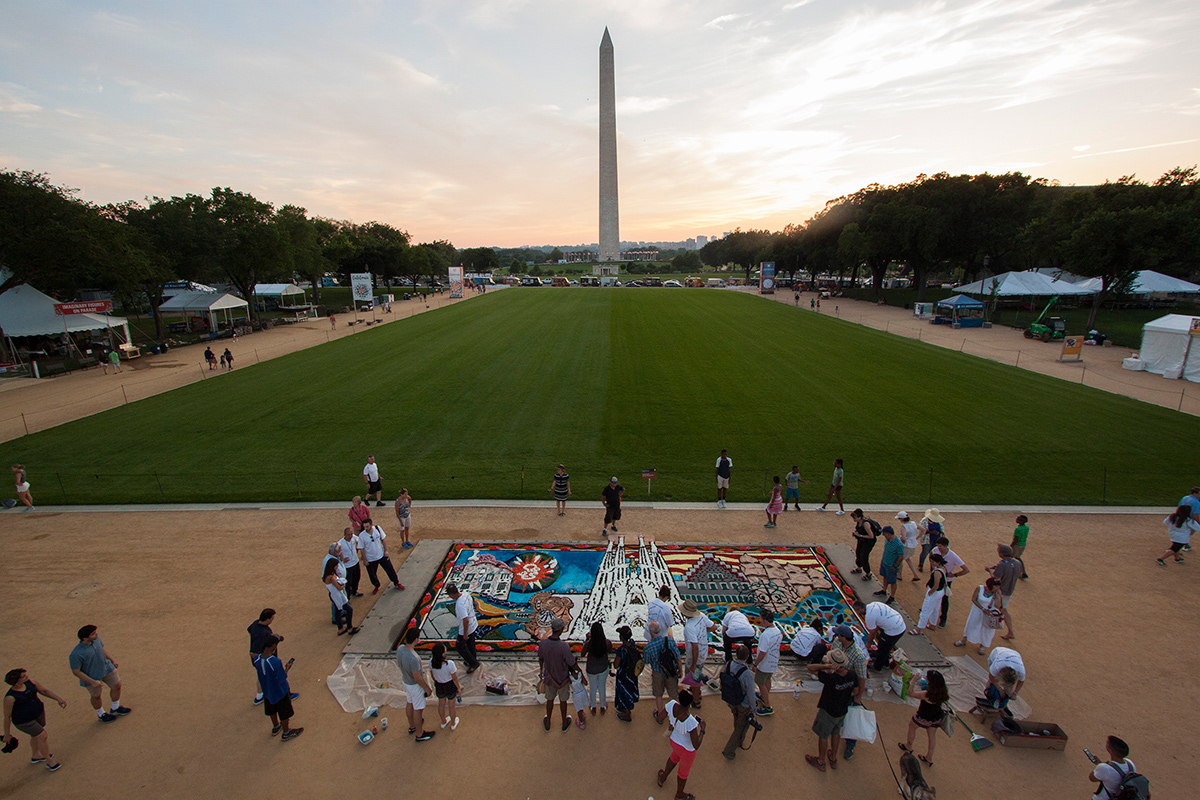The Cross-Continental Catifa Collaboration

Over the weekend, artists from both side of the Atlantic collaborated to create a new—and very short-lived—centerpiece on the National Mall. In the shadow of the Washington Monument, the Catalan catifa (flower carpet) added a burst of color to the gravel pathway across the Folklife Festival.
This detailed scene, composed of dyed sawdust and flowers, was the work of Catalonia program participants Vicenta Pallarès i Castelló and Angel Gallart Portas—but they had help from some locals. Guatemalan American Ubaldo Sánchez practices the same tradition with a different name: alfombra de aserrín. Festival regulars may remember his installment last year as part of the On the Move program, created along with the Viajeros de las Americas.
While planning this year’s Festival, we enlisted the help of Sánchez and alfombra coordinator Yolanda Alcorta. We knew we wanted to bring representatives of the Federació Catalana d’Entitats Catifaires, but we knew it would be easier to use materials from the United States. Communicating primarily with WhatsApp, Pallarès was able to ship their special mineral-based dyes from Barcelona to Sánchez’s team in Virginia, where they mixed it with local sawdust in time for the Festival.
Under an unforgiving sun, both teams worked side by side on top of a paper outline. Pallarès and Gallart were joined by fifteen members of their federation back home. As hours passed, as hundreds of handfuls of colored sawdust were patted down, a central image emerged: Antoni Gaudí’s Sagrada Família in Barcelona.
“We wanted to show off the best that we have, and that is Catalan Modernism,” Pallarès explained through a translator.



The architectural designs are their way of bringing Catalonia to the United States—plus their way of inviting us to Catalonia, she said. At the end of a discussion session with all the catifaires (flower carpet makers), Pallarès invited Sánchez and Alcorta to an annual conference in Europe of artists who share the tradition. If they accept, they will be the first group to represent North America.
Originating in Europe likely as a Catholic practice, especially around the Corpus Christi celebration, the ephemeral art form made its way to the Americas by the Spanish. They are still common in Catalonia and across Central America—whether for Corpus Christi, spring festivals, or now secular events.
As discussion presenter Olivia Cadaval stated simply, “With the movement of people, we have the movement of traditions.”
It turns out, the traditions don’t deviate too much across the ocean and generations. When it comes to the materials used, both teams have learned to be resourceful.
“You use whatever you have around you—in the forest, in the street, in your home,” Gallart said. “If you have a carpenter on your street, you use sawdust.”
With the same mindset, Sánchez gets his sawdust for free from a cabinet maker in Virginia. Sometimes it’s more coarse, sometimes more fine, sometimes almost too dark to dye, but he always finds a way to use what is provided. The Catalan team quickly adapted to their Virginian materials as well.
Just as they share methods of creation, so do the two teams share the catifa’s destruction. Last year, when the On the Move alfombra was completed, Honduran band members led Festival visitors in a procession through the sawdust. The precise outlines blurred, the materials scattered back into the earth. This year, at the end of Sunday’s festivities, the cercavila (parade) of Catalan giants, devils, beasts, and musicians led the way through, with the audience following behind.
It brought the first week of the 2018 Festival to a bittersweet close, to see something so beautiful so quickly obliterated. But in its three short days, it brought people together across continents: a true art of collaboration.

The Federació Catalana d’Entitats Catifaires will be with us for the remainder of the Festival, July 4 to 8, working on a (smaller, shadier) catifa in the Flower Carpet area of the Catalonia program. Come see and try your own hand at this living tradition.
Elisa Hough is the editor for the Smithsonian Center for Folklife and Cultural Heritage.

